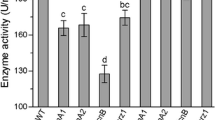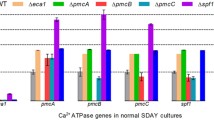Abstract
The Pal/Rim pathway essential for fungal adaptation to ambient pH has been unexplored in Beauveria bassiana, a classic fungal entomopathogen. Here, we show the characterized Pal pathway comprising transcription factor PacC and upstream six Pal partners (PalA/B/C/F/H/I) in B. bassiana. Their coding genes were all transcribed most abundantly in standard wild-type culture under the alkaline condition of pH 9. Deletion of pacC or each pal gene resulted in a significant delay of culture acidification in a minimal broth (initial pH = 7.3). This delay concurred with altered accumulation levels of intra/extracellular organic acids and drastically depressed expression of some enzyme genes required for the syntheses of oxalic and lactic acids. Our deletion mutants except ΔpalI showed growth defects and maximal sensitivity to NaCl, KCl, LiCl, or sorbitol at pH 9, an alkaline condition leading to fragmented vacuoles in their hyphal cells exposed to osmotic stress. In these mutants, conidiation was significantly facilitated at pH 3 more than at pH 7 but suppressed slightly at pH 9. Mild virulence defects also occurred in the absence of pacC or any pal gene. These changes were restored by targeted gene complementation. Taken together, PacC and Pal partners regulate the growth, conidiation, and osmotolerance of B. bassiana in a pH-dependent manner, highlighting their vitality for the fungal pH response.





Similar content being viewed by others
References
Arst HN Jr, Peñalva MA (2003) pH regulation in Aspergillus and parallels with higher eukaryotic regulatory systems. Trends Genet 19:224–231
Arst HN Jr, Bignell E, Tilburn J (1994) Two new genes involved in signaling ambient pH in Aspergillus nidulans. Mol Gen Genet 245:787–790
Calcagno-Pizarelli AM, Negrete-Urtasun S, Denison SH, Rudnicka JD, Bussink HJ, Múnera-Huertas T, Stanton L, Hervás-Aguilar A, Espeso EA, Tilburn J, Arst HN Jr, Peñalva MA (2007) Establishment of the ambient pH signaling complex in Aspergillus nidulans: PalI assists plasma membrane localization of PalH. Eukaryot Cell 6:2365–2375
Cervantes-Chávez JA, Oetiz-Castellanos L, Tejeda-Sartorius M, Gold S, Ruiz-Herrera J (2010) Functional analysis of the pH responsive pathway Pal/Rim in the phytopathogenic basidiomycete Ustilago maydis. Fungal Genet Biol 47:446–457
Chen Y, Zhu J, Ying SH, Feng MG (2014) Three mitogen-activated protein kinases required for cell wall integrity contribute greatly to biocontrol potential of a fungal entomopathogen. PLoS ONE 9, e87948
Cornet M, Gaillardin C (2014) pH signaling in human fungal pathogens: a new target for antifungal strategies. Eukaryot Cell 13:342–352
Cupertino FB, Freitas FZ, de Paula RM, Bertolini MC (2012) Ambient pH controls glycogen levels by regulating glycogen synthase gene expression in Neurospora crassa: new insight into pH signaling pathway. PLoS ONE 7, e44258
Daval S, Lebreton L, Gracianne C, Guillerm-Erckelboudt AY, Boutin M, Marchi M, Gazengel K, Sarniguet A (2013) Strain-specific variation in a soilborne phytopathogenic fungus for the expression of genes involved in pH signal transduction pathway, pathogenesis and saprophytic survival in response to environmental pH changes. Fungal Genet Biol 61:80–89
Díez E, Alvaro J, Espeso EA, Rainbow L, Suárez T, Tilburn J, Arst HN Jr, Peñalva MA (2002) Activation of the Aspergillus PacC zinc finger transcription factor requires two proteolytic steps. EMBO J 21:1350–1359
Espeso EA, Tilburn J, Sanchez-Pulido L, Brown CV, Valencia A (1997) Specific DNA recognition by the Aspergillus nidulans three zinc finger transcription factor PacC. J Mol Biol 274:466–480
Fang WG, Zhang YJ, Yang XY, Zheng XL, Duan H, Li Y, Pei Y (2004) Agrobacterium tumefaciens-mediated transformation of Beauveria bassiana using an herbicide resistance gene as a selection marker. J Invertebr Pathol 85:18–24
Fernández-Martínez J, Brown CV, Diez E, Tilburn J, Arst HN Jr, Peñalva MA, Espesso EA (2003) Overlap of nuclear localization signal and specific DNA binding residues within the zinc finger domain of PacC. J Mol Biol 334:667–684
Fomina M, Hillier S, Charnock JM, Melville K, Alexander IJ, Gadd GM (2005) Role of oxalic acid overexcretion in transformations of toxic metal minerals by Beauveria caledonica. Appl Environ Microbiol 71:371–381
Fonseca-García C, León-Ramirez CG, Ruiz-Herrera J (2012) The regulation of different metabolic pathways through the Pal/Rim pathway in Ustilago maydis. FEMS Yeast Res 12:547–556
Gadd GM (1999) Fungal production of citric and oxalic acid: importance in metal speciation, physiology and biogeochemical processes. Adv Microbiol Physiol 41:47–92
Galindo A, Calcagno-Pizarelli AM, Arst HN Jr, Peñalva MA (2012) An ordered pathway for the assembly of ESCRT-containing fungal ambient pH signaling complexes at the plasma membrane. J Cell Sci 125:1784–1795
Herranz S, Rodríguez JM, Bussink HJ, Sanchez-Ferrero JC, Arst HN Jr, Peñalva MA, Vincent O (2005) Arrestin-related proteins mediate pH signaling in fungi. Proc Natl Acad Sci U S A 102:12141–12146
Hervás-Aguilar A, Galindo A, Peñalva MA (2010) Receptor-independent ambient pH signaling by ubiquitin attachment to fungal arrestin-like PalF. J Biol Chem 285:18095–18102
Huang W, Shang YF, Chen PL, Gao Q, Wang CS (2014) MrPacC regulates sporulation, insect cuticle penetration and immune evasion in Metarhizium robertsii. Environ Microbiol 17:994–1008
Kirkland BH, Eisa A, Keyhani NO (2005) Acid as a fungal acaracidal virulence factor. J Med Entomol 42:346–351
Lamb TM, Mítchell AP (2003) The transcription factor Rim101p governs ion tolerance and cell differentiation by direct repression of the regulatory genes NRG1 and SMP1 in Saccharomyces cerevisiae. Mol Cell Biol 23:677–686
Lewis MW, Robalino IV, Keyhani NO (2009) Uptake of the fluorescent probe FM4-64 by hyphae and haemolymph-derived in vivo hyphal bodies of the entomopathogenic fungus Beauveria bassiana. Microbiol-SGM 155:3110–3120
Livak KJ, Schmittgen TD (2001) Analysis of relative gene expression data using real-time quantitative PCR and the 2−ΔΔCT method. Methods 25:402–408
Lucena-Agell D, Galindo A, Arst HN Jr, Peñalva MA (2015) Aspergillus nidulans ambient pH signaling does not require endocytosis. Eukaryot Cell 14:545–553
Luo ZB, Li Y, Mousa J, Bruner S, Zhang Y, Pei Y, Keyhani NO (2014) Bbmsn2 acts as a pH-dependent negative regulator of secondary metabolite production in entomopathogenic fungus Beauveria bassiana. Environ Microbiol 17:1189–1202
Magnuson JK, Lasure LL (2004) Organic acid production by filamentous fungi. In: Tkacz JS, Lange L (eds) Advantages in fungal biotechnology for industry, agriculture, and medicine. Kluwer Academic/Plenum Publishers, Dordrecht, pp 307–340
Merhej J, Richard-Forget F, Barreau C (2011) The pH regulatory factor Pac1 regulates Tri gene expression and trichothecene production in Fusarium graminearum. Fungal Genet Biol 48:275–284
Mingot JM, Tilburn J, Diez E, Bignell E, Orejas M, Widdick DA, Sarkar S, Brown CV, Caddick MX, Espeso EA, Arst HN Jr, Peñalva MA (1999) Specificity determinants of proteolytic processing of Aspergillus PacC transcription factor are remote from the processing site, and processing occurs in yeast if pH signaling is bypassed. Mol Cell Biol 19:1390–1400
Mingot JM, Espeso EA, Díez E, Peñalva MA (2001) Ambient pH signaling regulates nuclear localization of the Aspergillus nidulans PacC transcription factor. Mol Cell Biol 21:1688–1699
Negrete-Urtasun S, Reiter W, Díez E, Dension SH, Tilburn J, Espeso EA, Peñalva MA, Arst HN Jr (1999) Ambient pH signal transduction in Aspergillus: completion of gene characterization. Mol Microbiol 33:994–1003
Nobile CJ, Solis N, Myers CL, Fray AJ, Deneault JS, Nantel A, Mitichell AP, Filler SG (2008) Candida albicans transcription factor Rim101 mediates pathogenic interactions through cell wall functions. Cell Microbiol 10:2180–2196
O’Meara TR, Holmer SM, Selvig K, Dietrich F, Alspaugh JA (2013) Cryptococcus neoformans Rim101 is associated with cell wall remodeling and evasion of the host immune responses. mBio 4:e00522–12
O’Meara TR, Xu WJ, Selvig KM, O’Meara MJ, Mitchell AP, Alspaugh JA (2014) The Cryptococcus neoformans Rim101 transcription factor directly regulates genes required for adaption to the host. Mol Cell Biol 34:673–684
Peñalva MA, Arst HN Jr (2002) Regulation of gene expression by ambient pH in filamentous fungi and yeasts. Microbiol Mol Biol Rev 66:426–446
Peñalva MA, Arst HN Jr (2004) Recent advances in the characterization of ambient pH regulation of gene expression in filamentous fungi and yeasts. Annu Rev Microbiol 58:425–451
Peñalva MA, Tilburn J, Bignell E, Arst HN Jr (2008) Ambient pH gene regulation in fungi: making connections. Trends Microbiol 16:291–300
Peñalva MA, Lucena-Agell D, Arst HN Jr (2014) Liaison alcaline: Pals entice non-endosomal ESCRTs to the plasma membrane for pH signaling. Curr Opin Microbiol 22:49–59
Prusky D, Yacoby N (2003) Pathogenic fungi: leading or led by ambient pH? Mol Plant Pathol 4:509–516
Qiu L, Wang JJ, Chu ZJ, Ying SH, Feng MG (2014) Phytochrome controls conidiation in response to red/far-red light and daylight length and regulates multistress tolerance in Beauveria bassiana. Environ Microbiol 16:2316–2318
Selvig K, Alspaugh JA (2011) pH response pathways in fungi: adapting to host-derived and environmental signals. Mycobiology 39:245–256
St Leger RJ, Joshi L, Roberts DW (1997) Adaptation of proteases and carbohydrates of saprophytic, phytopathogenic and entomopathogenic fungi to the requirements of their ecological niches. Microbiol-SGM 143:1983–1992
St Leger RJ, Joshi L, Roberts D (1998) Ambient pH is a major determinant in the expression of cuticle-degrading enzymes and hydrophobin by Metarhizium anisopliae. Appl Environ Microbiol 64:709–713
St Leger RJ, Nelson JO, Screen SE (1999) The entomopathogenic fungus Metarhizium anisopliae alters ambient pH, allowing extracellular protease production and activity. Microbiol-SGM 145:2691–2699
Tamura K, Peterson D, Peterson N, Stecher G, Nei M, Kumar S (2011) MEGA5: molecular evolutionary genetics analysis using maximum likelihood, evolutionary distance, and maximum parsimony methods. Mol Biol Evol 28:2731–2739
Tilburn J, Sarkar S, Widdick DA, Espeso EA, Orejas M, Mungroo J, Peñalva MA, Arst HN Jr (1995) The Aspergillus PacC zinc finger transcription factor mediates regulation of both acid- and alkaline-expressed genes by ambient pH. EMBO J 14:779–790
Trushina N, Levin M, Mukherjee PK, Horwitz BA (2013) PacC and pH dependent transcriptome of the mycotrophic fungus Trichoderma virens. BMC Genomics 14:138
Vincent O, Rainbow L, Tilburn J, Arst HN Jr, Peñalva MA (2003) YPXL/I is a protein interaction motif recognized by Aspergillus PalA and its human homologue AIP1/Alix. Mol Cell Biol 23:1647–1655
Wang CS, Feng MG (2014) Advances in fundamental and applied studies in China of fungal biocontrol agents for use against arthropod pests. Biol Control 68:129–135
Wang XX, He PH, Feng MG, Ying SH (2014) BbSNF1 contributes to cell differential, extracellular acidification, and virulence in Beauveria bassiana, a filamentous entomopathogenic fungus. Appl Microbiol Biotechnol 98:8657–8673
Xiao GH, Ying SH, Zheng P, Wang ZL, Xie XQ, St Leger RJ, Zhao GP, Wang CS, Feng MG (2012) Genomic perspectives on the evolution of fungal entomopathogenicity in Beauveria bassiana. Sci Rep-UK 2:483
Xie XQ, Li F, Ying SH, Feng MG (2012) Additive contributions of two manganese-cored superoxide dismutases (MnSODs) to antioxidation, UV tolerance and virulence of Beauveria bassiana. PLoS ONE 7, e30298
Xie XQ, Guan Y, Ying SH, Feng MG (2013) Differentiated functions of Ras1 and Ras2 proteins in regulating the germination, growth, conidiation, multi-stress tolerance and virulence of Beauveria bassiana. Environ Microbiol 15:447–462
Zou CG, Tu HH, Liu XY, Tao N, Zhang KQ (2010) PacC in the nematophagous fungus Clonostachys rosea controls virulence to nematodes. Environ Microbiol 12:1868–1877
Acknowledgments
We thank Jun-Ying Li (Analysis Center of Agrobiology and Environmental Sciences, Zhejiang University) for technical assistance with TEM.
Author information
Authors and Affiliations
Corresponding author
Ethics declarations
This article does not contain any studies with human participants or animals performed by any of the authors.
Funding
This study was funded by the National Natural Science Foundation of China (Grant Numbers 31270537, 3157110241, and 31321063).
Conflict of interest
All the authors declare no conflict of interest.
Electronic supplementary material
Below is the link to the electronic supplementary material.
ESM 1
(PDF 3667 kb)
Rights and permissions
About this article
Cite this article
Zhu, J., Ying, SH. & Feng, MG. The Pal pathway required for ambient pH adaptation regulates growth, conidiation, and osmotolerance of Beauveria bassiana in a pH-dependent manner. Appl Microbiol Biotechnol 100, 4423–4433 (2016). https://doi.org/10.1007/s00253-016-7282-5
Received:
Revised:
Accepted:
Published:
Issue Date:
DOI: https://doi.org/10.1007/s00253-016-7282-5




